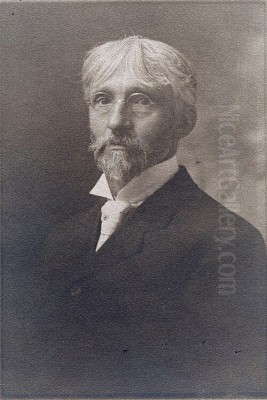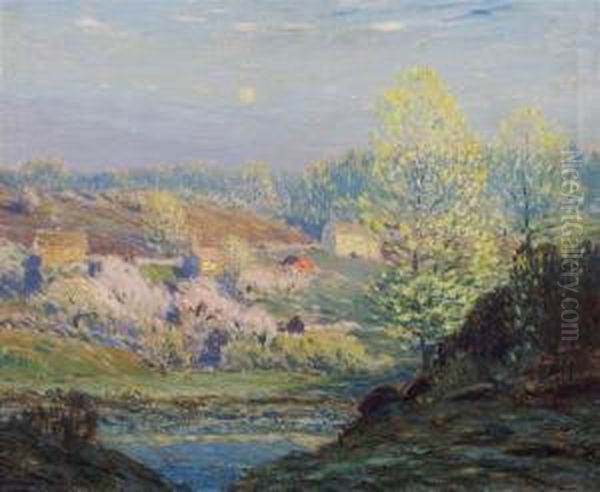
Leonard Ochtman stands as a significant figure in American art history, a painter whose career bridged the evocative nuances of Tonalism with the brighter palette of Impressionism. Born in the Netherlands but spending his formative and professional years in the United States, Ochtman became renowned for his sensitive landscape paintings, particularly those capturing the serene beauty of the Connecticut countryside. Beyond his own canvases, he was a pivotal figure in the development of the Cos Cob Art Colony and played an essential role in the early years of the Bruce Museum in Greenwich, Connecticut, leaving an indelible mark as both an artist and a community builder.
Early Life and Formative Years
Leonard Ochtman was born on October 21, 1854, in Zonnemaire, a small village in the province of Zeeland, the Netherlands. His father was a decorative painter, suggesting an early exposure to the visual arts within the family environment. The course of his life changed significantly in 1866 when, at the age of twelve, his family emigrated to the United States, settling in Albany, New York. This move placed the young Ochtman in a new cultural context during his formative teenage years.
His initial foray into the working world was not directly in fine art but related to craftsmanship. In Albany, he served as an apprentice at a woodworking company, learning skills that likely honed his sense of form and structure. However, the artistic impulse remained strong. His early artistic experiences involved working as a draftsman at an engraving firm in Albany, providing him with practical skills in line and composition, before he eventually shifted his focus entirely towards painting.
Forging an Artistic Identity in New York
In 1879, seeking greater opportunities and immersion in the art world, Ochtman moved to New York City. This was a crucial step, placing him in the heart of America's burgeoning art scene. While largely considered self-taught, he did briefly attend classes at the Art Students League of New York, a vital institution for many aspiring artists. However, his primary education came from direct observation, practice, and engagement with the artistic currents of the time.

During his early years in New York, Ochtman began to develop his distinctive landscape style. He started exhibiting his work, with his paintings appearing at the prestigious National Academy of Design beginning in 1882. His developing style showed the influence of several important artistic traditions. He deeply admired the Dutch Tonalist painters of the Hague School, such as Anton Mauve and Jacob Maris, whose works emphasized mood, atmosphere, and subtle gradations of tone, often depicting the landscapes of their homeland with quiet poetry.
Furthermore, Ochtman drew inspiration from the French Barbizon school painter Jean-Baptiste-Camille Corot, known for his lyrical landscapes and mastery of light and atmosphere. Within the American context, Ochtman associated with prominent figures like George Inness, a leading exponent of American Tonalism, whose spiritual and moody landscapes resonated with Ochtman's own sensibilities. He also formed a close association with fellow Tonalist painter Charles Warren Eaton, with whom he shared lodgings for a time, fostering an environment of mutual artistic exploration.
The Allure of the Connecticut Landscape: Cos Cob
A pivotal moment in Ochtman's life and career occurred in 1891 when he and his wife, Mina Fonda Ochtman (also a talented painter), moved from New York City to Cos Cob, a small community within Greenwich, Connecticut. This area, with its picturesque Mianus River, rolling hills, and proximity to Long Island Sound, offered the kind of tranquil, intimate landscape scenery that deeply appealed to his artistic temperament. The move proved transformative, not just for his art but also for the local art scene.
The Ochtmans quickly became central figures in what would evolve into the Cos Cob Art Colony, one of America's earliest and most important centers for Impressionism and related styles. Their home became a gathering place for artists seeking respite from the city and inspiration from the surrounding natural beauty. Leonard Ochtman, along with Mina, was instrumental in fostering the collegial and creative atmosphere that defined the colony.
The Cos Cob Art Colony attracted numerous prominent artists, creating a vibrant hub of artistic activity. Figures such as John Henry Twachtman and J. Alden Weir, pioneers of American Impressionism, were key members. Other notable artists associated with the colony included Childe Hassam, Theodore Robinson, and later, Elmer MacRae (who married Mina's daughter). While many Cos Cob artists fully embraced Impressionism, Ochtman maintained his unique blend, incorporating Impressionist attention to light while retaining a Tonalist emphasis on mood and harmony.
Ochtman's Artistic Vision: Tonalism and Impressionism
Leonard Ochtman's mature artistic style is often characterized as occupying a space between Tonalism and Impressionism. While he was undoubtedly influenced by the Impressionists' focus on light, color, and capturing fleeting moments, his work generally retained the more subdued palette, unified atmosphere, and poetic sentiment associated with Tonalism. He was less concerned with the scientific analysis of light and broken color favored by French Impressionists and many of his American counterparts.
Instead, Ochtman excelled at capturing specific times of day and particular atmospheric conditions – the soft light of dawn, the quiet glow of twilight, the hazy humidity of summer, or the crisp air of autumn. He sought to convey the emotional resonance of a landscape, the feeling it evoked, rather than merely documenting its appearance. His brushwork, while often painterly, aimed for subtle transitions and harmonious compositions.
His favored subjects were the landscapes surrounding his Connecticut home. He painted numerous views of the Mianus River, capturing its gentle curves and reflections under varying light and seasons. Works like Winter Sun on the Mianus River (1896) exemplify his ability to render the quiet beauty of a winter landscape with delicate light effects. Views of Long Island Sound also feature prominently in his oeuvre, often depicted under expansive, atmospheric skies. Titles such as Scenes on the Mianus River and Long Island Sound recur, indicating his deep connection to these specific locales.
Recognition and Professional Standing
Ochtman's dedication and distinct artistic voice earned him considerable recognition during his lifetime. His regular participation in major exhibitions, including those at the National Academy of Design, the Pennsylvania Academy of the Fine Arts, and the Art Institute of Chicago, brought his work to national attention. He was elected an Associate of the National Academy of Design (ANA) and achieved the status of full Academician (NA) in 1904, a significant honor reflecting his standing among his peers.
His work garnered numerous awards, underscoring its critical acclaim. Among his accolades were a medal from the Brooklyn Art Club in 1891, a medal at the World's Columbian Exposition in Chicago in 1893, and a gold medal from the Philadelphia Art Club in 1894. He also received awards at the Pan-American Exposition in Buffalo (1901), the Universal Exposition in St. Louis (1904), and prizes from the Salmagundi Club in New York, an important artists' organization where he was an active member. This consistent recognition cemented his reputation as a leading American landscape painter.
A Dedicated Educator
Beyond his personal artistic practice, Leonard Ochtman was deeply committed to art education. He believed in sharing his knowledge and fostering the next generation of artists. For approximately two decades, beginning around 1910 (though sources vary slightly on the start date, the source text mentions 1918 for a school opening), he ran a successful summer school of landscape painting from his home or studio in Cos Cob. This school attracted numerous students eager to learn his approach to capturing the nuances of the natural world.
His teaching extended beyond Cos Cob. In 1905, Ochtman served as the director of the summer school at the Byrdcliffe Arts and Crafts Colony in Woodstock, New York. Byrdcliffe was another important utopian art colony focused on integrating art, craft, and life. His involvement there highlights his respected position within the broader network of American art colonies. Through his teaching, Ochtman influenced numerous aspiring painters, including figures like Charles H. Davis, imparting his sensitivity to light, atmosphere, and landscape composition.
The Bruce Museum and Community Leadership
Ochtman's contributions to the artistic life of his community extended to institutional development. He played a crucial founding role at the Bruce Museum in Greenwich, Connecticut. When Robert Moffat Bruce bequeathed his mansion to the town for a museum of history, natural history, and art in 1908, Ochtman was appointed as the first art advisor. He served in this capacity for many years, helping to shape the museum's early art collection and exhibition program.
His guidance was instrumental in establishing the Bruce Museum's focus on American Impressionism, particularly works by artists associated with the Cos Cob Art Colony. He helped the museum acquire important pieces and organized exhibitions that highlighted the significance of the local art movement. His wife, Mina Fonda Ochtman, was also active in the local art scene, co-founding the Greenwich Society of Artists and serving as its president, further solidifying the Ochtman family's central role in the region's cultural development.
Artistic Relationships and Collaborations
Throughout his career, Ochtman maintained connections with a wide circle of artists. His early association with Charles Warren Eaton in New York was significant for both painters as they explored Tonalist aesthetics. His leadership in the Cos Cob Art Colony placed him in regular contact with major figures like John Henry Twachtman, J. Alden Weir, Childe Hassam, and Theodore Robinson, fostering an environment of shared ideas, even amidst stylistic differences.
He also collaborated on specific projects, such as the joint exhibition he held with the prominent American Impressionist Frederick Carl Frieseke in Detroit in 1913. This event brought together two distinct, yet related, approaches to landscape painting. His network included other respected artists active in Cos Cob and the broader region, such as Emil Carlsen, known for his still lifes and landscapes, Elmer MacRae, who documented the life of the colony, and George Wharton Edwards, an illustrator and painter who was also part of the Cos Cob milieu. These interactions enriched his own practice and contributed to the vitality of the American art scene.
Later Years and Enduring Legacy
Leonard Ochtman continued to paint and remain active in the art community throughout his later years. He maintained his home and studio, "Grayledge," in the Stanwich district of Greenwich, finding endless inspiration in the surrounding Connecticut landscape. He passed away in Greenwich on October 27, 1934, at the age of 79, leaving behind a substantial body of work and a significant legacy.
His enduring contribution lies in his mastery of landscape painting, characterized by a unique synthesis of Tonalist mood and Impressionist light. He captured the poetic essence of the American landscape, particularly the gentle beauty of coastal Connecticut, with sensitivity and technical skill. Furthermore, his role as a co-founder and central figure of the Cos Cob Art Colony was crucial in establishing one of the most important centers for American art at the turn of the twentieth century. His dedication as a teacher and his foundational work with the Bruce Museum further cemented his importance as not just an artist, but also a vital force in shaping American art institutions and communities.
Conclusion
Leonard Ochtman remains a respected figure in American art history, a Dutch-born painter who embraced the landscape of his adopted country. His work offers a bridge between the introspective quietude of Tonalism and the vibrant light of Impressionism, resulting in landscapes imbued with both atmosphere and subtle luminosity. Through his paintings, his teaching, and his leadership in organizations like the Cos Cob Art Colony and the Bruce Museum, Ochtman made lasting contributions to the development and appreciation of American landscape painting, securing his place as a master of his craft and a key figure in the cultural life of his time. His art continues to resonate with viewers who appreciate the serene, poetic beauty he found in the natural world.